The polling feature in Zoom allows you to create and use single choice or multiple-choice polling questions during your meetings. You will be able to launch the poll during your meeting and gather the responses from your attendees. You can download a report of polling data during or after the meeting. Polls can also be conducted anonymously if you do not wish to collect participant information with the poll results.
- Hosts must use the Zoom desktop client(app) to manage polling. Polls cannot be launched from a mobile phone, tablet, or Chromebook.
- While co-hosts can launch polls already created for a meeting, only the original meeting host can edit or add polls during a meeting.
- Zoom allows a max of 50 polls per meeting, with each poll having a max of 10 questions.
- If a poll is relaunched in a meeting, the poll report will only display the last poll occurrence. If you know you will need to launch the same poll twice and want both sets of data, consider creating a second poll with the same questions as the original.
Note for users of screen readers: letters in parentheses in the instructions below refer to corresponding areas on example images. If you have any questions about these instructions, contact eLearning for assistance.
Upload CSV to Canvas-Scheduled Zoom Meeting
The Zoom tab in Canvas only offers the ability to add polls via an uploaded CSV worksheet. Follow the directions below to upload polls into a Zoom meeting scheduled in Canvas.
Access Meeting in Zoom
- Navigate to Zoom (A) in your Canvas course navigation menu.
- Click the Topic Link (B) for the Zoom Meeting in the Upcoming Meetings list that you want to add a poll to. The meeting must have already been created to add a poll; if you have not created the meeting, schedule a New Meeting (C) before attempting to proceed.

- After selecting the topic link, scroll to the bottom of the page to the Poll (D) Section.
- Click Download a CSV Template (E).
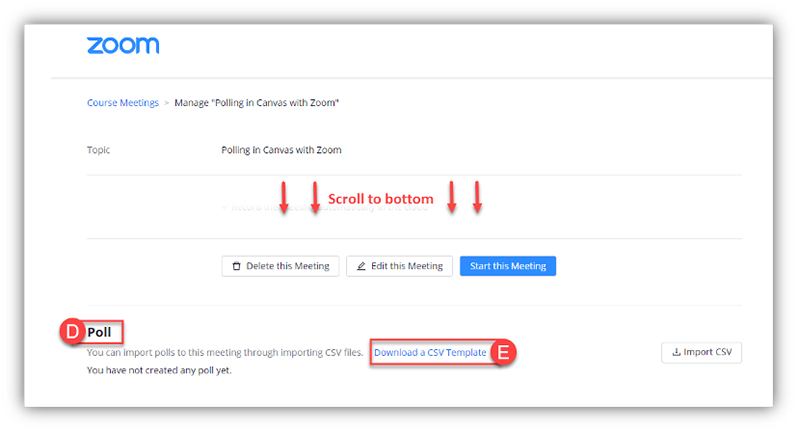
Create CSV Poll
Open the downloaded CSV using a spreadsheet application, such as Microsoft Excel.
Replace the sample data with your poll information (read the directions below carefully):
- Title (A) — Polling title must always be on its own row and denotes the start of a new poll. You can create up to 25 polls for a single meeting.
- Questions Name (B) — Poll questions are entered in this column. The first question must be one row below the Poll Title. Zoom allows 10 questions per poll.
- Question Type (C) — denotes whether participants can select multiple answers (multiple) or only one answer (single).
- Answers (D) — Answer choices are entered in the column. The first choice must be one row below the Question Type. Zoom allows up to 10 answer options per question.
- Delete any of the sample information you do not want in your poll.

- Click Save As (E).
- Enter a new name (F) for the CSV file. Make sure to keep the file type as a .csv (CSV UTF-8 (Comma delimited) ).
- Click Save (G).

Upload Polls
- Click Import CSV (A).
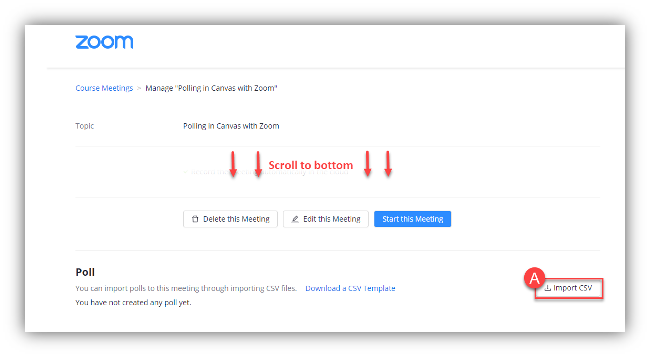
- Select your Poll.csv file (B).
- Click Open (C).

- Confirm that your imported polls show as you expected on the bottom of the page. (You may need to refresh the page).
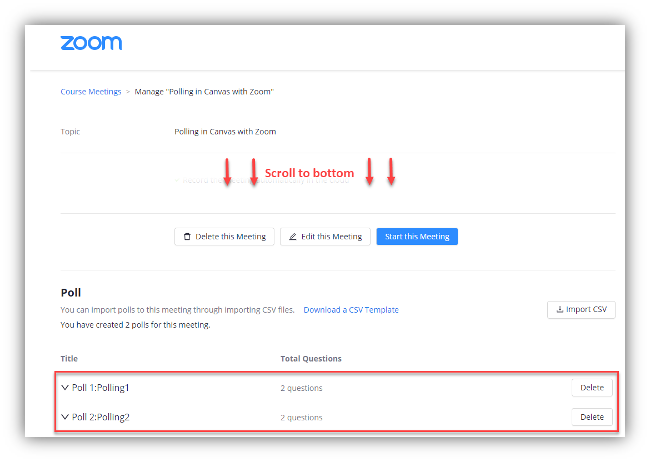
Launch Polls in Meeting
Start the scheduled Zoom meeting that has polling enabled.
- Click Polls/quizzes (A) in the meeting controls. If it is not on the meeting controls check in More option.
- Hover over to select the poll you would like to launch.
- Click Launch (B).
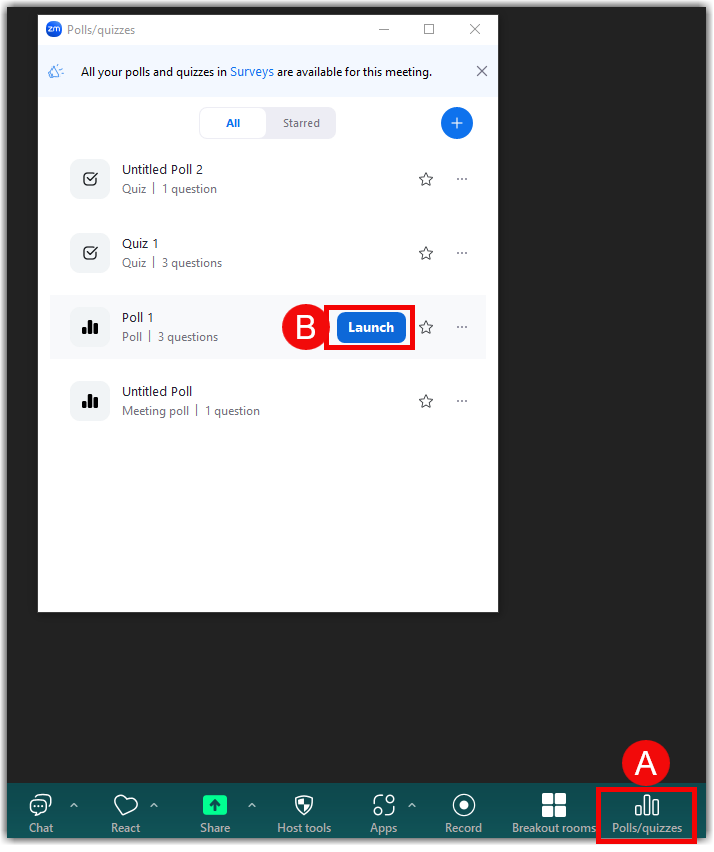 The participants in the meeting will be prompted to answer the polling questions. Only the host will be able to see the results live.
The participants in the meeting will be prompted to answer the polling questions. Only the host will be able to see the results live. - The poll can also be shared when live by using the Get QR code (D) option. When you are ready to stop the poll, click End Polling (E).
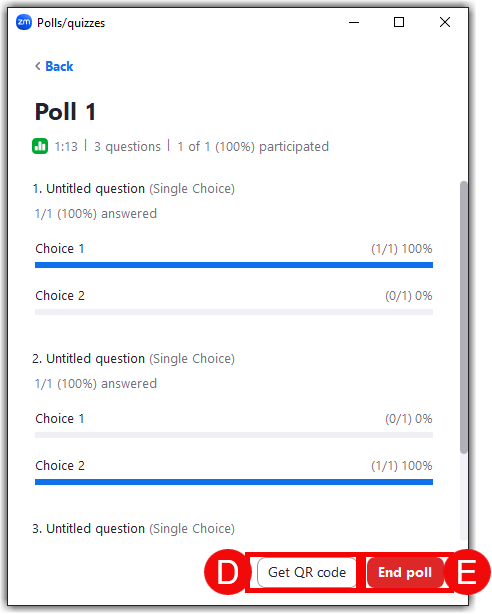
View and Share Results
Poll results can be downloaded and shared, or you can re-launch the poll.
- If you would like to share the results to the participants in the meeting, click Share Results (A). Click the More (B) option beside share results to see more features:
- Re-launch poll: You can re-launch the poll using this option. If a poll is relaunched in a meeting, the poll report will only display the last poll occurrence. If you know you will need to launch the same poll twice and want both sets of data, consider creating a second poll with the same questions as the original to avoid relaunching.
- Download Results: To view the full report for this poll, click the Download Results button. This will launch your default web browser so that you can download the entire poll report, which shows what each participant chose, instead of the percentages of each choice. Check Download a Report Post-Meeting given below for more information.
- View Results from Browser: Launches your default web browser and displays the same polling results on the web page.
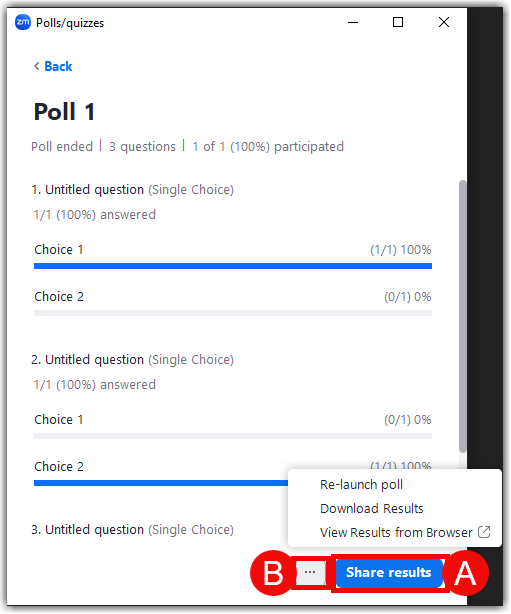
- Participants will then see the results of the polling questions. You will need to Stop sharing results in order to open another poll.
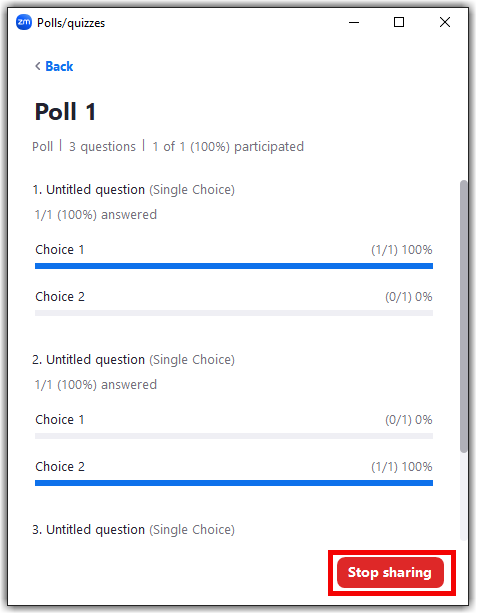
Optional: You can choose Re-launch to restart this poll or stop sharing results and choose the next poll to launch from the drop down.
Download a Report Post-Meeting
You can download a report of the poll results after the meeting. When viewing a report of the poll results, take note of these things:
- If registration was turned on and the poll was not anonymous, it will list the participants' names and email addresses.
- If registration was not on, the polling report will show the profile names of unauthenticated participants and the names and email addresses of authenticated participants.
- If the poll was anonymous, it will show "anonymous" for the participants' names and email addresses.
When a Zoom meeting is recorded to the cloud, users can access this recording and download the files. Once the files are downloaded, users can upload the video into UAB’s media management platform (Kaltura). Follow the instructions below to to download a Zoom Meeting Recording and upload it to Kaltura (My Media).
Note for users of screen readers: letters in parentheses in the instructions below refer to corresponding areas on example images. If you have any questions about these instructions, contact eLearning for assistance.
Download Recording
- After recording a meeting to the cloud, access your Zoom account by navigating to uab.zoom.us in a web browser.
- Click Recordings (A) on the left-hand navigation then click the Topic (B) of the desired meeting.

- All the files included in the recording will be listed. Hover over the desired video file and click the down arrow (C) to download that file.

- The video file will download to your computer and be named GMT[DATE]xxx.mp4.

Upload to Kaltura (My Media)
Once you have a video file downloaded from Zoom, you can upload this into Kaltura so that it can be shared in or out of Canvas.
- Login to Canvas then select My Media from global Navigation.
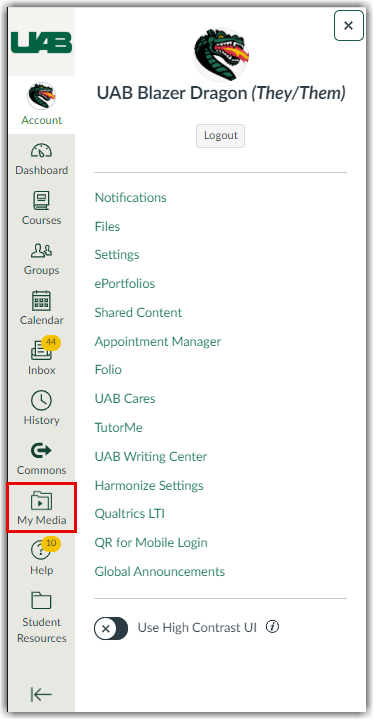
- Click Add New (C) at the top right and select Media Upload (D).

- Next, click + Choose a file to upload (E) and locate the GMT video file in your downloads file area. TIP: Instructors can alternatively click and drag the video file into the box.

- The video will start to load and will display a green success banner message at the top when it is successfully upload. Instructors can edit the Name (F), Description (G), and Tags (H) while the video is still uploading.

- Click Save (I) when you have finished. Click Go to Media (J) to see the media or Go to My Media (K) to return to all media that is in My Media.

- The video will begin processing on Kaltura’s servers. While it is processing, instructors can go ahead and embed or publish this video in their Canvas course. Visit UAB’s Kaltura webpage to learn more about editing, captioning, and publishing videos.
Instructors can use the Zoom Web Conferencing tool to create breakout rooms during their meetings. This feature allows you to split the participants into separate sessions automatically or manually. This guide covers assigning in-meeting.
You can also create these rooms and before starting the meeting and Pre-assigned breakout rooms. See the Pre-assign Breakout Rooms guide.
Notes:
- Only Hosts/Co-hosts can create and manage Breakout rooms.
- Users joined into the Zoom meeting from the Zoom Mobile App can participate in breakout rooms, but cannot manage them.
- If the meeting is being cloud recorded, it will only record the main room, regardless of what room the meeting host is in. If local recording is being used, it will record the room the participant who is recording is in. Multiple participants can record locally.
- You can create up to 100 breakout rooms.
Note for users of screen readers: letters in parentheses in the instructions below refer to corresponding areas on example images. If you have any questions about these instructions, contact eLearning for assistance.
Creating Breakout Rooms (In-Meeting)
The following instructions show how to create breakout rooms while in the meeting. User can also create and pre-assign users before the meeting.
- To setup a breakout room session, start a Zoom meeting and click the Breakout Rooms (A) icon. If you do not see this button, check under More (Three dots). Note: Only Host's can see this button in order to create and start breakout rooms.

- Determine how many rooms (B) you want to create and if you want Automatic, Manual, or Self-chosen assignments (C).
- Automatically created rooms will take the participants and place them randomly into a breakout room.
- Manually will require the instructor to assign the students to the individual rooms after creating the rooms.
- Let participants choose room allows all users to see the breakout rooms button on the toolbar and enter/leave any breakout room made in that meeting.
- Click Create Breakout Rooms (D) to create the rooms. Note: This does not start the breakout session yet.
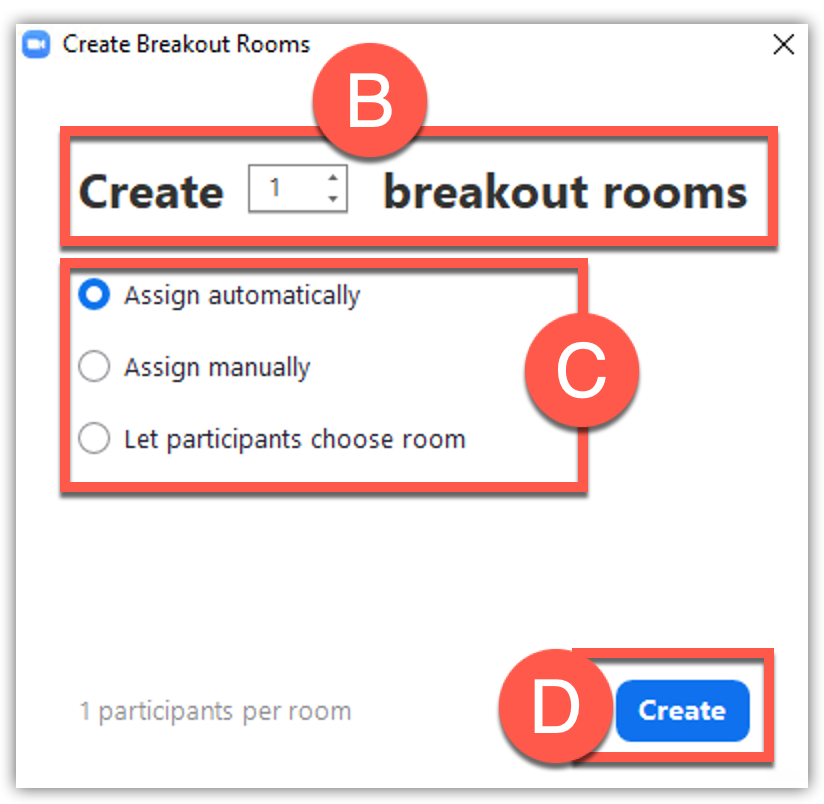
Assign Participants & Edit Rooms (In-Meeting)
Before opening the rooms, hosts can assign or move attendees, create/delete rooms, and set several settings as to how the breakout rooms perform.
- Click Assign (E) beside the desired room and check the boxes beside desired participants to assign them to that room.
- Hover your mouse over a breakout room to see the options to Rename or Delete (F) that room.
- Click Recreate (H) at the bottom to see the options to start over with creating Breakout Rooms again.
- Click Add Room (G) to add additional breakout rooms.
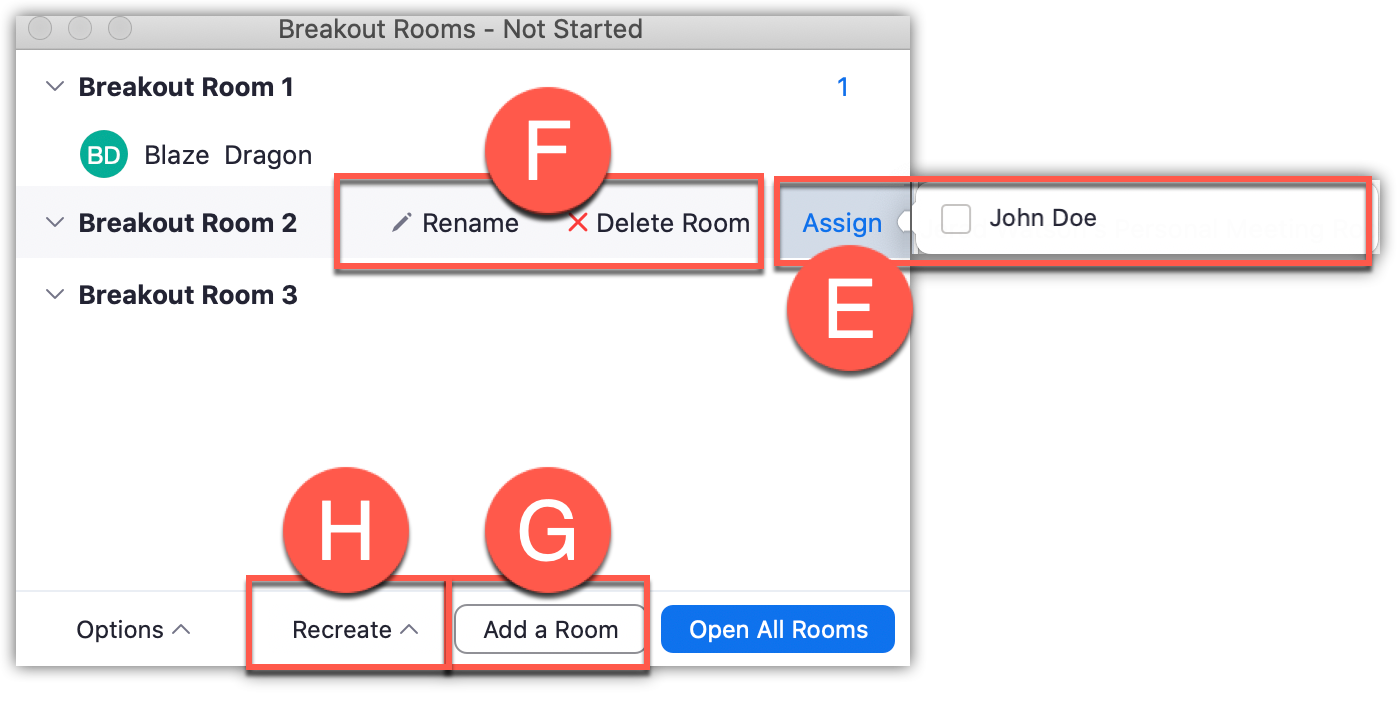
Breakout Room Options
- Click Options (A) to set all the options before opening the rooms.
- Allow participants to choose room: Checking this option allows all users to leave any assigned rooms and enter any breakout room in that Zoom meeting.
- Move all participants into breakout rooms automatically: Checking this option will move all participants into the breakout rooms automatically. If this option is unchecked, the participants will need to click Join to be added to the breakout room.
- Allow participants to return to the main session at any time: If this option is checked, the participants can move back to the main session from their meeting controls. If this is disabled, they need to wait for the host to end the breakout rooms.
- Automatically move all selected participants in breakout rooms to main meeting: If this option is checked, the participants will be moved to the main meeting session when breakouts are closed. The participants would not get 60 seconds to wrap up their discussion before moving to main meeting.
- Breakout rooms close automatically after x minutes: If this option is checked, the breakout rooms will automatically end after the configured time.
- Notify me when the time is up: If this option is checked, the host will be notified when the breakout room time is up.
- Countdown after closing breakout rooms: If this option is checked, the participants will be given a countdown of how much time they have left before being returned to the main room.
- Once the rooms are setup, the button Open all Rooms (B) will start the Breakout Rooms.
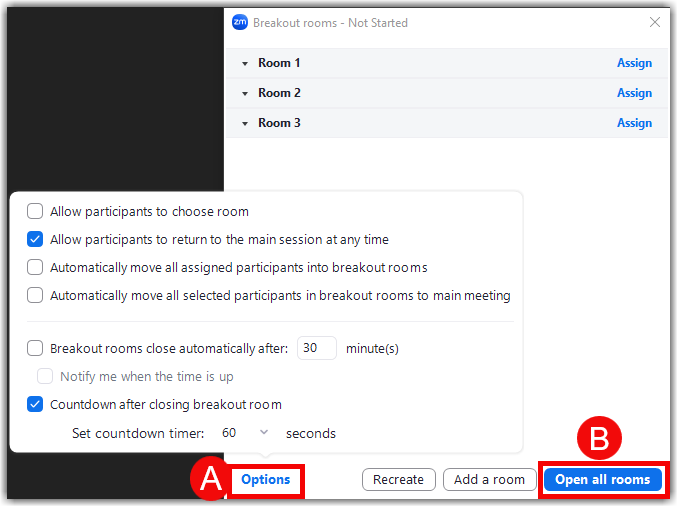
Manage Breakout Rooms
Once the breakout rooms have been started, the participants will be asked to join the Breakout Session. The host will stay in the main meeting until joining a session manually. If a participant has not joined the session yet, it will be noted by (not joined) next to their name.
- Any unassigned (A) participants will be labeled at the top. Hover over them to see the option to assign them.
- Hover over assigned participants to see the option to Move (B) them to another room.
- Click Broadcast (C) to type a message or record voice message that will be broadcast in all rooms.
- Click Join (D) beside the desired breakout room to join in to that room.
- Click Close All Room (E) to stop all rooms after the set countdown duration, shown to the host and participants, and return all participants back to the main meeting.
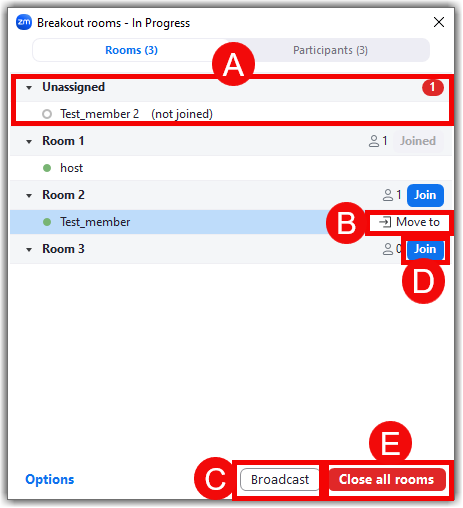
- When in a room, click Leave Room (F) to come back to the main session.

- A participant can request that you join there room, click join or later (G) on their request.
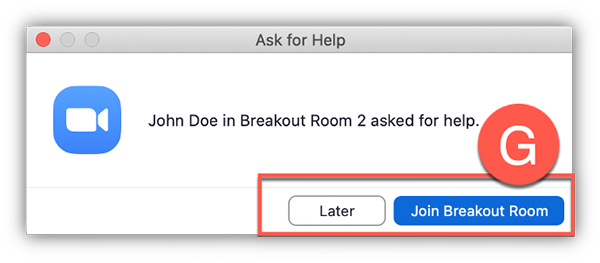
Assign Recording Privilege
Breakout Room sessions are not part of the main recording. If you want the breakout rooms to be recorded, you can assign multiple participants the ability to record locally.
- In a Zoom Meeting click on Participants (A).

- In the Participants menu navigate to the participant who will be granted recording privileges. Click More (B) next to their name then select the option to Allow Record on Computer (C).
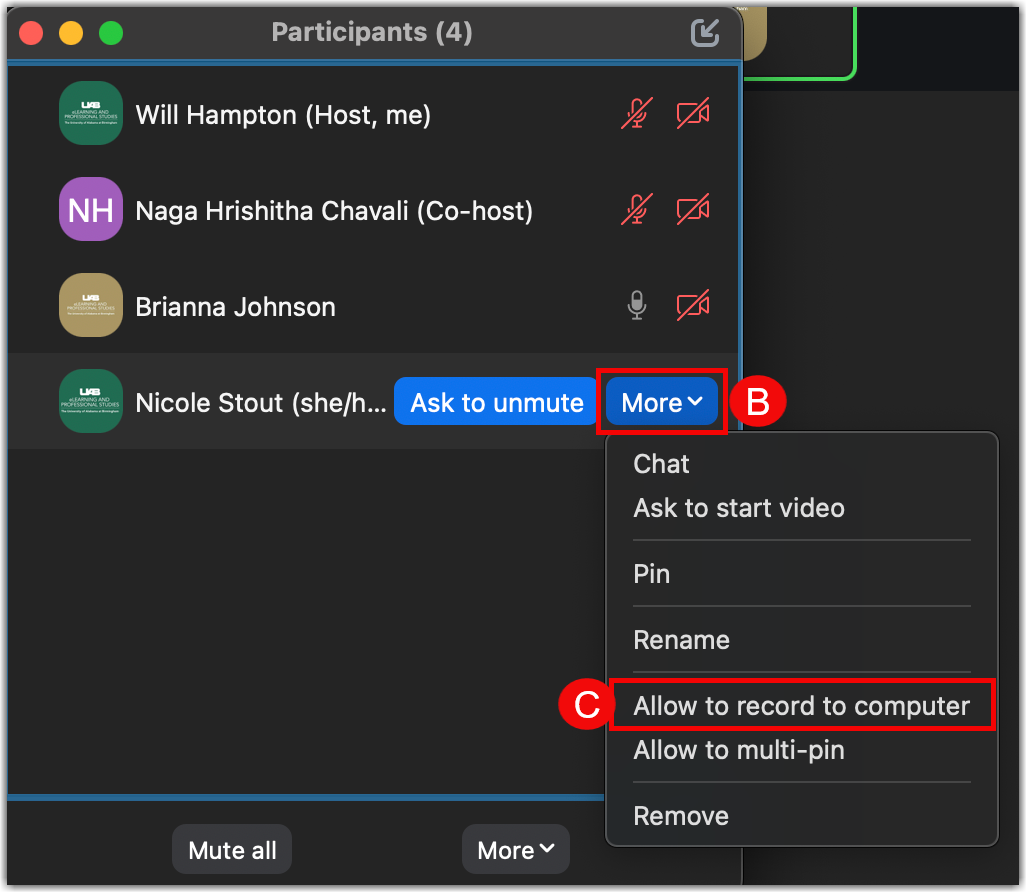
- The participant will receive the following notification:


These increased security measures along with the knowledge on how to manage participants in Zoom meetings will provide a more secure and positive environment. Watch the video above for a quick demo of the account changes and Zoom features. Below is a list of features and tips that can help the host and co-host manage participants and prevent unwanted users from disrupting Zoom meetings.
- In-meeting Host Tools Icon
- Waiting Room
- Limit Screen Sharing
- Disable Participant Annotation on Shared Content
- Mute Particpants
- Turn Off Webcam Feed
- Limit Chat
- Remove Participant
- Lock Meeting
- Force Authentication
In-meeting Host Tools Icon
Users with Zoom client 4.6.10 or higher now have the ability to access many of Zoom’s security features in one place. Learn how to update or download the most recent version of Zoom.
-
Instructions
- Start a Zoom meeting.
- Click the Host tools icon on the Zoom toolbar.

- The following settings can be enabled from the menu:
- Lock Meeting: Locks the meeting, keeping new participants from joining the meeting.
- Enable Waiting Room: Enables Waiting Room for incoming new participants or to move current participants into the Waiting Room.
- Hide profile pictures: All profile pictures will be hidden.
- Allow participants to:
- Share Screen: Allows participants to start Screen Shares
- Chat: Allows participants to use the chat function.
- Rename Themselves: Allows participants to rename themselves from the Participants panel.
- Unmute Themselves: Allows participants to unmute themselves without the host’s permission.
- Start video: Allows participants to start their video in the meeting.
- Share whiteboards: Allows participants to open and share a Zoom Whiteboard.
- Share notes: Allows participants to open and share Zoom Notes.
- Collaborate with Zoom Apps: Allows participants to view and work collaboratively with a Zoom App.
- Set meeting timers: Allows participants to set a meeting timer.
- Annotate on Shared Content: Allows participants to annotate over content shared during the meeting. The host can enable or disable annotation when the host is sharing.
- Remove Participant: Allows the removal of a participant from a meeting. The participant cannot rejoin.
- Suspend participant activities: This feature turns off all participants' video, audio, Zoom Apps, and ability to share their screen. Also locks the meeting to prevent participants from joining. This will apply to all participants, including those joined using a Zoom Room.
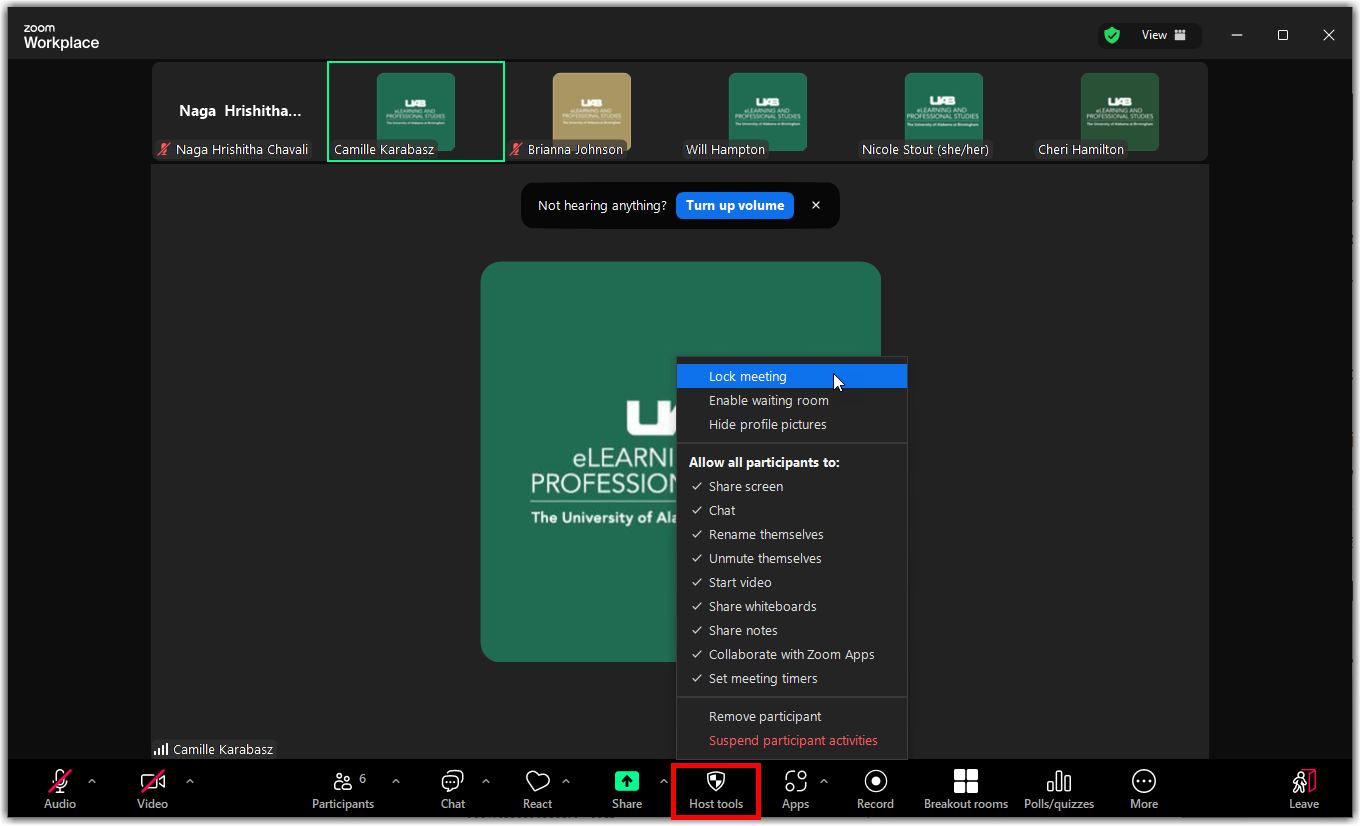
Use the Waiting room
The waiting room feature will be turned on by default for all meetings and participants. It will notify host/co-hosts that someone has entered the waiting room. Only let users in that you recognize. You may want to instruct your students to only type in their real name when joining your meetings.
-
Admitting participants during a meeting
- As the meeting host, click Participants.

- Click Admit to have the participant join the meeting.

- As the meeting host, click Participants.
-
Admit all participants from the Waiting Room
- As the meeting host, click Participants.

- Click Admit all.

- As the meeting host, click Participants.
-
Sending participants to the Waiting Room during a meeting
- As the meeting host, click Participants.

- Click More next to the participant's name and choose Put in Waiting Room.

- As the meeting host, click Participants.
-
Enable/Disable Waiting Room during a meeting
There are two places hosts/co-hosts can enable/disable the waiting room in a meeting.
From Host Tools Icon
- Click the Host tools icon on the Zoom toolbar.

- Check Enable Waiting Room to enable and uncheck to disable.

From Participants
- As the meeting host, click Participants.

- Click More and choose Enable Waiting Room on Entry to enable or disable the feature.

- Click the Host tools icon on the Zoom toolbar.
Limit Screen Sharing
By default all participants can share their screen in your meeting. You can remove this capability from participants so that only the host can share the screen.
-
Prevent participants from screen sharing
There are two places hosts/co-hosts can enable/disable the waiting room in a meeting.
From Host Tools Icon
- Click the Host tools icon on the Zoom toolbar.

- Uncheck Share Screen to disable, check to enable

From Advanced Sharing Options
- In the host controls, click the arrow next to Share Screen.

- Click Advanced Sharing Options.

- Under " Who can share?" choose Only Host.

- Close the window.
- Click the Host tools icon on the Zoom toolbar.
-
Set account to not allow meeting participants to share their screen by default for all future meetings
- Log in to Zoom at uab.zoom.us.
- Click Settings on the left side of the screen.
- Click In Meeting (Basic).
- Scroll down and select Host Only under Screen sharing.

Disable Participant Annotation on Shared Content
By default, participants can annotate (draw on, highlight, insert shapes, etc.) on content being shared by someone. The person sharing content can turn off the ability for participants to annotate.
-
Instructions
- Share Content during Zoom meeting.
- Click More (3 dots).
- Click Disable annotation for others.

Mute Participants
Participants can unmute themselves in your meeting. Hosts/co-hosts can mute individuals or everyone in the room and can even remove the ability for participants to talk entirely.
-
Mute an individual
- Click Participants in the host controls to display the participants list.

- Hover over a participant and click Mute.

- Click Participants in the host controls to display the participants list.
-
Mute all participants
- Click Participants in the host controls to display the participants list.

- Click Mute All at the bottom of the Participants Window.

- If you want to remove the ability for participants to unmute themselves, uncheck the box. Click Yes to apply this setting.

- Click Participants in the host controls to display the participants list.
Turn off Camera/Webcam Feed
By default, Zoom allows all participants to turn on their webcam. There is not a setting to prevent all users from turning on the video, but you can stop participant's video feed one at a time. This also prevents those particular participants from starting their video again in that meeting unless requested by the host/co-host.
-
Stop Video of Participant
- Click Participants in the host controls to display the participants list.

- Hover over a participant, click More, then click Stop Video.

- Click Participants in the host controls to display the participants list.
Limit Chat
By default users can send chat messages that can be seen by everyone in the Zoom meeting. Host/co-hosts can limit the chat to only be seen by the host or turn off participant chat all together.
-
Change who participants can chat with
- While in a meeting, click Chat in the meeting controls.
- Click More button at the top to display in-meeting chat settings.
- Choose who attendees can chat with (No one or Host only).

-
Turn on/off participant chat
Host/co-hosts can toggle the ability for participants to be able to chat.
- Click the Host tools icon on the Zoom toolbar.

- Uncheck Chat to disable, check to enable

- Click the Host tools icon on the Zoom toolbar.
Remove Participant(s) From Meeting
Hosts can remove an unwanted user from a meeting so that they can no longer disrupt the meeting.
-
Remove individual participant
- Click Participants in the host controls to display the participants list.

- Hover over a participant, click More, then click Remove.

NOTE: Users removed from a meeting CANNOT rejoin that same meeting or future meetings with the same meeting ID. If you are wanting to remove someone that is not a threat, you can choose to move them into the waiting room instead. - Click Participants in the host controls to display the participants list.
-
Remove one or more individuals
Hosts/co-hosts can remove one or multiple individuals through the security icon.
- Click the Host tools Icon on the Zoom toolbar.

- Click Remove Participant.
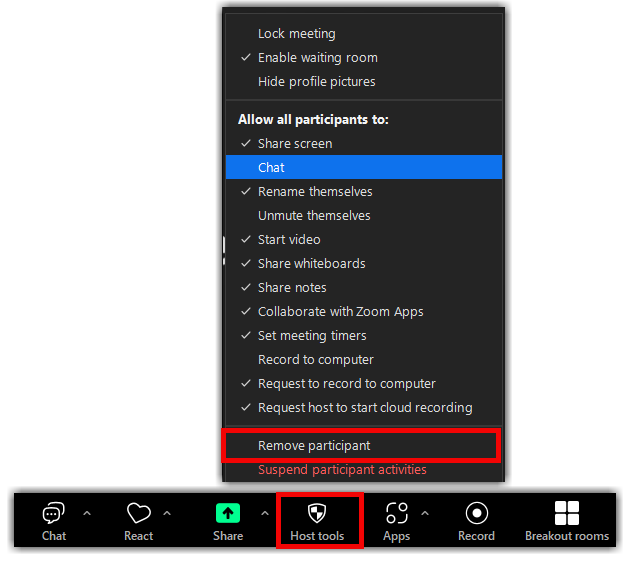
- Click remove beside the name of each person to remove them.

- Click the Host tools Icon on the Zoom toolbar.
Lock Meeting
Hosts can lock a meeting to keep further users from joining the meeting. Once the meeting is locked, no one can join even if they have the link and/or password.
-
Instructions
- Click Participants in the host controls to display the participants list.

- Click More at the bottom of the Participants window, and click Lock meeting.

Alternatively, users can lock the meeting from the Host tools Icon.
- Click the Host tools Icon icon on the Zoom toolbar.

- Click Lock Meeting.

- Click Participants in the host controls to display the participants list.
Force Authentication
By default, anyone with the link can join meetings as a guest. You can force users to authenticate before being allowed to join your meeting. When scheduling a meeting, you can decide if it will require authentication and can limit it to users a with a Zoom account or users with a Zoom account at UAB.
-
Instructions
- When scheduling a meeting, click the check box beside Only authenticated users can join.
- Choose the desired authentication you will allow for this meeting. (only one can be chosen)
- Sign in to Zoom: requires users to sign into a Zoom account. This allows anyone with a Zoom account to join your meeting.
- Sign in with UAB Email Address/SSO: requires users to sign in to a Zoom account with their @uab.edu or @uabmc.edu email. Users with UAB eLearning account will need to sign in with SSO.

If a participant tries to join the meeting or webinar and is not logged into Zoom, or logging in with the specified email domain, they will receive one of the following messages:
If they are not logged into Zoom:

If they are logged in with the wrong email domain:

Students will need to sign in with SSO while anyone that has an account outside of UAB eLearning (free, UA system, HIPAA) will need to login with their Zoom email and password.
Faculty, staff, and students who do not have an account can click Sign in with SSO, type UAB in the domain field, and provide their BlazerID and password. They will be provisioned a Zoom account and let in to the meeting.

Basic Security Tips
- Do not post the join link to your Zoom meetings on public facing websites or social media.
- If you are hosting a public event, you should use Registration and enable manual approval so that users can be identified before being allowed access to join.
- Course meetings should be scheduled using the Zoom tab within Canvas so that the join link is only available once authenticated in Canvas.
- External guests can be invited by personal email initiations.
- Do not post your personal meeting (PMI) room id or link publicly.
- Keep an eye on the participants in your meeting and act swiftly if you see an unwanted user.
- Report any unwanted users to Zoom and UAB eLearning. Please provide the Meeting ID and date of the incident.
Still Have Questions?
- Attend our Zoom Security Webinar on April 6, 9am
- Watch our most recent Zoom training
- Visit the UAB eLearning Zoom webpage
- Ask your question using the academic technology support form
- More information on annotations in zoom
Instructors must have an account with UAB's Zoom in order to use the Zoom tab in Canvas. If you have never created an account, you can click here, type in your BlazerID and your account will automatically be created.
If you already have a free Zoom account (limited to 40 minute meetings) or an account with UA system and desire to use the Zoom tab in Canvas, follow the instructions below to switch to new account.
- If you need assistance with your UAB Zoom account in Canvas, please fill out this academic tech support form.
How to Switch to UAB Zoom Account
1. Go to https://uab.zoom.us/saml/login.
2. Type in your BlazerID and Password if prompted.
3. If asked, click "Switch to the New Account" option.

4. Click the "Confirm your email address" button when prompted.
5. An email will be sent to your UAB email address from no-reply@ zoom.us. (It may take a few minutes.)
6. Click the "Switch to the new account button" found in the email.

7. Click the "I Acknowledge and Switch" button, when prompted.

8. Your account is now under UAB Zoom and can be used in Canvas. Reattempt to access the Zoom tab in Canvas.
For more information on using Zoom in Canvas, check out our instructor and student guides.